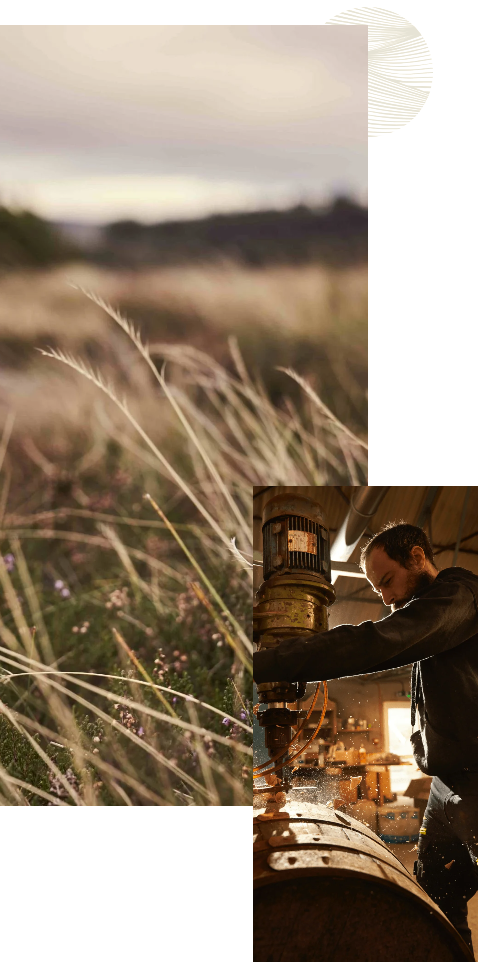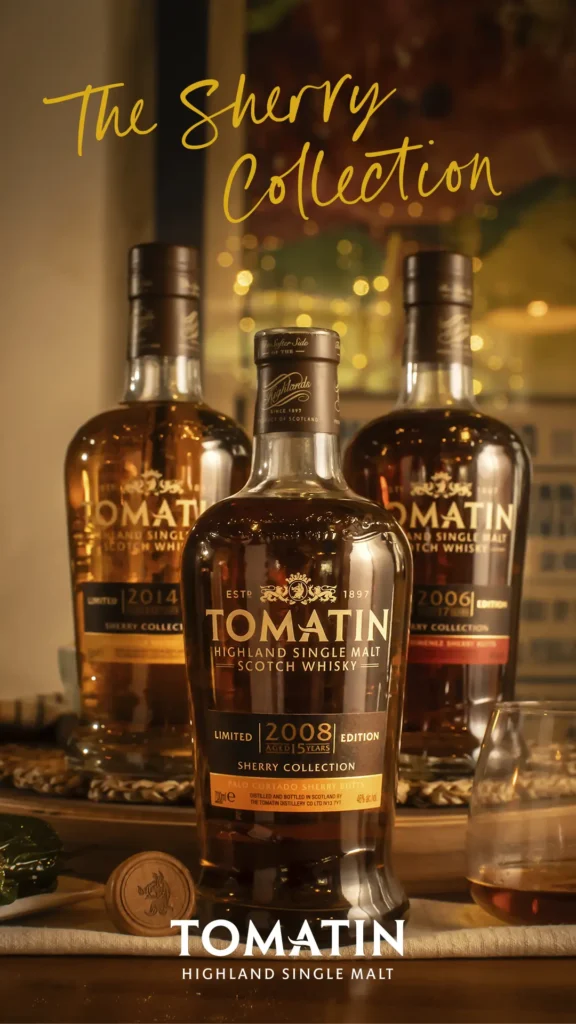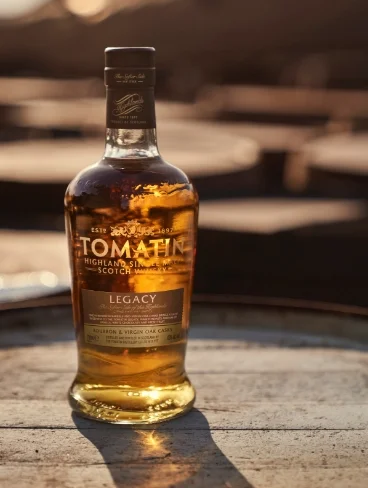Discover the Sherry Collection
A trio of unique single malts showcasing classic Tomatin whisky matured in the finest Sherry butts.
To What Matters

Full of Life
The Scottish Highlands
Full of stories, of open arms and warm welcomes.
Full of hidden depths and of the love of families spanning generations.
Full of what matters.
This is our home. This is us. This is our whisky.
Each one a memento of a passion and knowledge that only comes
from making whisky over several lifetimes.
Each one a toast to the very landscape in which we live, to our
community bonded by shared purpose and in everything we do.
Quite simply, our whiskies reflect us.
Always have and always will.
Tomatin. To what matters.

INTRODUCING THE SHERRY COLLECTION: a trio of limited-edition releases celebrating the renaissance of Sherry.
These expressions have been finished in Manzanilla, Palo Cortado and Pedro Ximénez Sherry butts, highlighting the exceptional flavours that these casks bring to our Highland single malt.
Every bottle of whisky we make is distilled with pride.
Our stories matter
Spirit. It lives in every one of us. United in a shared purpose. It soars. Making individuals into families. Bringing us together. Closer than ever before.
Whisky Lifestyle
An Ode to Character
To celebrate the conclusion of this simply exceptional collection, we thought it was fitting to create an ode to character – we simultaneously laud and celebrate both Warehouse 6 and our current custodian, Graham. Characters full of spirit. …
Whisky Lifestyle
Guest Blog: Behind the scenes with Joshua Nathaniel Jones
It’s not often you’re asked to shoot a whisky brand film, so I was excited from the start when I …
News
Quality matters to us here at Tomatin
We are extremely proud to announce our latest product accolades from the prestigious 2022 IWSC awards. Only three whiskies in …
Spirit. It lives in every one of us. United in a shared purpose. It soars. Making individuals into families. Bringing us together. Closer than ever before.

OUR STORY
Sharing true Highland warmth from our home to yours to yours
In 1897 Tomatin was nothing but an isolated and idyllic setting for a distillery. With the new Highland Railway came opportunities, and so the distillery was born. Since then, the distillery has been at the heart of the community and the community at the heart of the distillery. Today, the Tomatin Legacy lives on in the form of an exciting and varied range of Highland single malt Scotch whiskies.
#towhatmatters
Share your own toast to what matters
Step into Sherry`s modern revival with our Tomatin Sherry Collection. 🥃
This new trio celebrates the vibrant culture of Sherry and its heartland, Spain — from food and drink, to arts and culture.
These single malts, finished in Manzanilla, Palo Cortado and Pedro Ximénez casks, capture the exciting diversity of Sherry`s flavours.
Curious about Sherry culture? Discover the Tomatin Sherry Collection today.
#Tomatin #SingleMalt #Whisky #SherryCollection #SherryCask

Our community is at the heart of everything we do at Tomatin, just like the distillery is still firmly at the heart of its community after more than 125 years.
You`re invited to join our community — book your visit to Tomatin Distillery today, via the link in our bio.
#Tomatin #TomatinDistillery #Highland #Scotch #community

How do we decide what matters?
It could be a generous gesture you weren`t expecting, no matter how small; being able to share something you care about with loved ones; or making time to enjoy a simple pleasure.
Whatever matters to you, let`s raise a toast to it 🥃
#Tomatin #ToWhatMatters #Highland #Whisky #Community

What do you think of our Tomatin 14 Year Old?
🥃 Aged in the finest Tawny Port casks, this velvety single malt treats you to rich flavours of red berries, toffee and nuts before culminating in a long-lasting, fruity finish.
#Tomatin #Highland #Scotch #SingleMalt #PortCask

Toasting to the Sherry Triangle 🥃
Manzanilla Sherry, which features in our new Sherry Collection, is made exclusively in Sanlúcar de Barrameda. It`s one of the three towns that form Spain`s historic Sherry Triangle, along with Jerez de la Frontera and El Puerto de Santa María.
It`s in this fabled region that we source the finest Sherry casks to age our single malt whiskies.
Ready to dive deeper into the world of Sherry? Explore the Tomatin Sherry Collection today.
#Tomatin #SingleMalt #Whisky #SherryCollection #SherryCask

Did you know that Tomatin is one of the highest distilleries in Scotland? We sit 315 metres above sea level — which means you can enjoy some stunning views of the surrounding landscape on your visit.
The only thing that`s higher than our altitude? Our whisky-making standards 🥃
#Tomatin #Highland #Scotch #Whisky #Mountains
